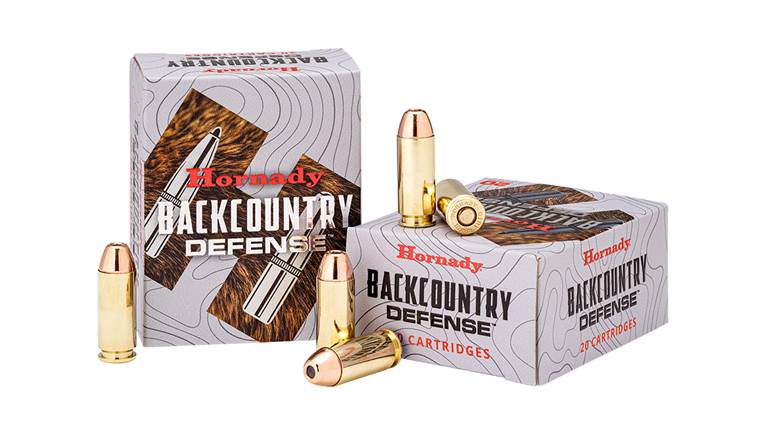
When .357 Mag. double-action revolvers fell out of favor with law enforcement in the 1980s, it forced many of the budget-priced and mid-grade double-actions out of the market. But, in recent years, defensive revolvers have enjoyed something of a revival as certain states have instituted regulations to further complicate the ownership of semi-automatic pistols, and companies such as Charter Arms, Rock Island Armory and Taurus have stepped up to address the needs of cost-conscious enthusiasts with models starting in the $400 price range.
What we have seen little of are new mid-priced options that split the difference, finish-wise, between these budget guns and the higher-end double-action offerings from companies such as Smith & Wesson, Ruger and Kimber. Fitting neatly into this gap in the market is Rock Island’s recently added AL series of double-action revolvers, guns that are being manufactured by Alfa Proj in the Czech Republic.

Currently imported into the United States by Armscor as part of the Rock Island Armory catalog, the AL series includes blued or stainless-steel models with 2" or 4" barrels, adjustable or fixed sights, and chambering options including .22 Long Rifle, .22 WMR, 9 mm Luger (with moon clips) and .357 Mag. This evaluation takes a closer look at the snub-nose, six-shot, .357 Mag.-chambered AL3.1 model.
The AL3.1 is constructed wholly of polished stainless steel, including the barrel, frame, cylinder, controls and appointments (excluding the front sight). This gives the revolver an authoritative unloaded heft of 30.6 ozs., which works in its favor when shooting full-power .357 Mag. ammunition. Its designers borrowed features from other manufacturers while blending in some unique touches of their own, and the result is a sleek and familiar old-school appearance that’s easy on the eyes without simply cloning some other popular model.
This six-shot’s frame and cylinder are comparable in size to those of the Ruger GP100 or Smith & Wesson K-Frames. Although a variety of .357 Mag. K-Frame speedloaders are compatible with this model’s cylinder, subtle differences in the AL3.1’s external dimensions mean that most of the holsters made for Smith & Wesson models are not a good fit. Finding a suitable holster will take a bit of research, since there’s little in the way of model-specific options currently available.
The snub-nose barrel profile leans more toward that of the Colt Detective, with a rounded crown that extends slightly past the rest of the flattened muzzle. The 2" barrel’s full-length underlug serves as a protective shroud for the ejector rod. The relatively long and narrow serrated front sight, which is made of blued steel, is pinned to the barrel. The receiver’s topstrap features a deep, full-length groove that ends in a square notch that forms the rear sight.

Like Smith & Wesson and Colt revolvers, the AL3.1 has a removable plate on the right side that provides access to the inner components of the action. On the left side, a grooved release is pressed forward to allow the cylinder to swing out into the open position. The cylinder crane (or yoke) is sandwiched into the frame, much like that of a Charter Arms revolver. It’s an unusual configuration in that the crane extends all the way through to the right side of the frame rather than resting inside of an alcove milled into the frame.
The cylinder is fluted and rotates in a counterclockwise direction. Its crane swings out easily when released, and the cylinder spins freely when opened. The cylinder’s six chambers are recessed, meaning they are counterbored so that the cartridge rims rest flush with the rear of the cylinder when fully inserted.
The exposed hammer has a long, slender profile that ends in a grooved pad that aids in manually cocking the gun for single-action fire. The hammer is powered by a coil-spring assembly similar to those used in Ruger GP100 revolvers. A generously sized, rounded trigger guard houses a stainless-steel trigger with a grooved face. The trigger cycled smoothly in both double- and single-action modes. The double-action trigger pull was typical of factory revolvers, with a relatively long arc of travel and an 11-lb. break. The single-action trigger was better than one might expect; manually cocking the hammer resulted in a short, clean trigger pull of 3 lbs., 9 ozs.
A full-size, black rubber grip features finger grooves along the frontstrap with a pebbled texture on the sides for added purchase. This grip is a clamshell design with a solid backstrap that provides a rounded extension that rests in-between the top of the integral grip frame and the web of the shooting hand thumb. Instead of a single screw that passes all the way through the grip frame, a pair of short screws is used to secure the grip in place.
Although more compact five-shot revolvers with lightweight aluminum or polymer frames are popular for concealed carry, they can produce snappy levels of felt recoil depending on the ammunition used. The all-steel construction of the AL3.1 and its hand-filling rubber grip kept felt recoil to moderate levels when shooting .38 Spl. loads and worked to keep the revolver manageable when firing .357 Mag.
This revolver proved to be utterly reliable with all of the ammunition tested, and it functioned smoothly. Keeping an eye on the small screws of any handgun is a good idea during the first trip to the range, since they can sometimes loosen and fall out due to recoil; both of the sideplate screws stayed in place but needed tightening by the end of the testing process.
Armscor has done its American customers a favor by adding the Alfa Proj series of AL double-action revolvers to the Rock Island Armory lineup. They are sturdy, all-steel wheelguns that offer a solid step up in terms of finish and quality compared to budget-priced revolvers while costing less than most legacy designs.






































